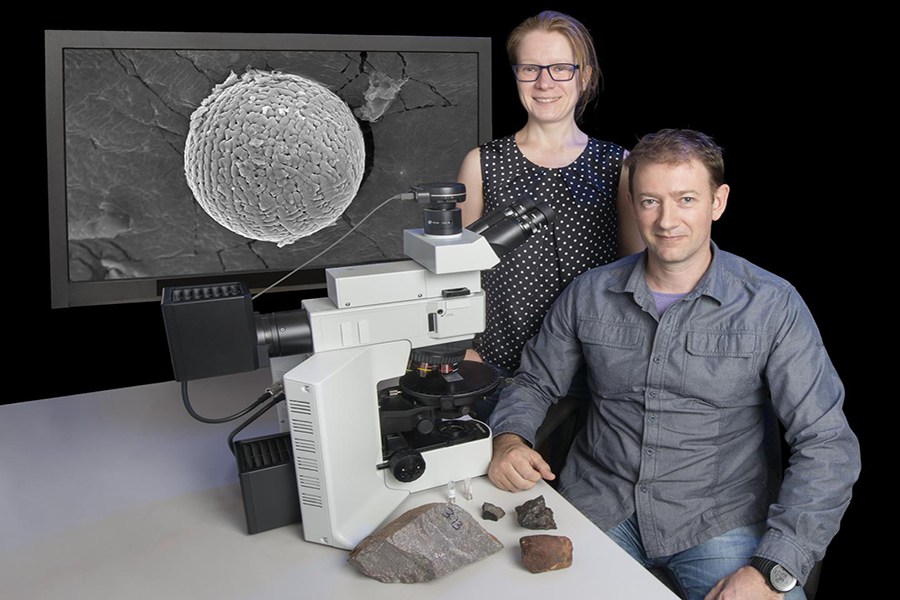Ancient space dust may reveal mysteries of Earth's early atmosphere
Loading...
Specks of ancient space dust, preserved in limestone in Western Australia's Pilbara region, could upend current theories about the history of oxygen on Earth.
By analyzing the chemistry of ancient micrometeorites, or microscopic flecks of meteor that are too small to burn up in the atmosphere and instead settle on Earth, a team of scientists was surprised to find that the Earth's upper air was flush with oxygen at a time when there wasn't supposed to be any.
"As geologists, we're taught that the Earth had no oxygen in its atmosphere before 2.3 to 2.4 billion years ago," explained Andrew Tomkins, a geologist at Monash University in Melbourne who led the analysis, reported Popular Mechanics. Dr. Tomkins and his team published their findings Wednesday in the journal Nature.
Scientists widely agree that Earth's early atmosphere had less than 0.001 percent of today's oxygen levels, since all available oxygen got absorbed into surface rocks. It wasn't until about 2.4 billion years ago that a major environmental change, the Great Oxidation Event, imbued the Earth's atmosphere with O2.
There is plenty of evidence, largely from previous research into ancient minerals, that Earth's lower atmosphere was nearly bare of oxygen. But until Tomkins's team took it on, no one had studied the upper reaches of the atmosphere, between 31 and 62 miles above the Earth’s surface. Nor has anyone found samples of micrometeorites as old as the ones recovered by Tomkins and his colleagues. Those are are almost a billion years older than the next oldest samples, as National Geographic reports.
"It therefore comes as a surprise that melted meteor fragments recovered from Archaean limestone indicate that the contemporaneous atmosphere above 75 kilometres was highly oxidized," wrote Kevin Zahnle of NASA Ames Research Center and Roger Buick of the astrobiology program at the University of Washington, in an independent commentary accompanying Wednesday's study.
Tomkins and his colleagues realized that micrometeorites – which actually are quite common on Earth – are a good way to study ancient air. These dust flakes careened through the Earth's atmosphere, interacting with any and all gases present, which affected how the meteors melted and what molecules they formed as they cooled. By looking at the chemical makeup of these ancient specks of space dust, the researchers knew they could work backward to determine what Earth's early atmosphere was composed of.
Australia's Pilbara region was a good place to look for fossilized space dust. It is known for having some of Earth's oldest rock formations. The team targeted limestone because it is dense enough to have protected these micrometeorites from water and weather for billions of years, as Popular Mechanics reported.
The scientists took samples of the limestone and dissolved it in a mild acid, finding dozens of micrometeorites left over.
"I guess it is that simple: We were the first to find meteorites this old simply because we were the first to look for them," Tomkins told Popular Mechanics.
When the team analyzed their ancient dust samples, they found that most of their micrometeorites had once been particles of iron that had oxidized and turned into the iron oxide minerals magnetite and wüstite, a mineral that is not usually found near the Earth's surface and therefore helps prove that the dust is actually from space, as Drs. Zahnle and Buick explain in their commentary.
Otherwise, the samples look the same as iron micrometeorites that fall to Earth today, which to Tomkins and his team means that the air high above the Earth must have had as much oxygen 2.7 billion years ago as it does today.
The tiny particles of space debris absorbed the oxygen as they settled to Earth at 7 to 44 miles per second. They would have been heated to a melting temperature at the top of Earth’s atmosphere and then cooled down very quickly – all in a matter of a few seconds – as they fell closer to the planet surface. This still would have given them time to accumulate oxygen from the upper atmosphere during their molten phase, because chemical reactions happen much faster at high temperatures.
"That's why they sample a specific range of altitudes – they stop being oxidized once they cool down," Tomkins told the Los Angeles Times.
That doesn't answer where the oxygen in the upper atmosphere would have come from 2.7 billion years ago, and why it didn't spread to the lower atmosphere.
Tomkins and his team believe that it could have formed when ultraviolet light from the sun broke apart water vapor and carbon dioxide, reports Popular Mechanics. The team plans to dig out more micrometeorites from around the world to learn more.
If it turns out that Earth's atmosphere really harbored plenty of oxygen before the evolution of the plants and other life that release it through photosynthesis, this could have huge implications on our study of air around other planets in search of life there.
"These guys have possibly shown us that there might be a lot of oxygen that has nothing to do with what we're looking for – the presence of life producing that oxygen," astrobiologist Timothy Lyons of the University of California in Riverside, told National Geographic.






